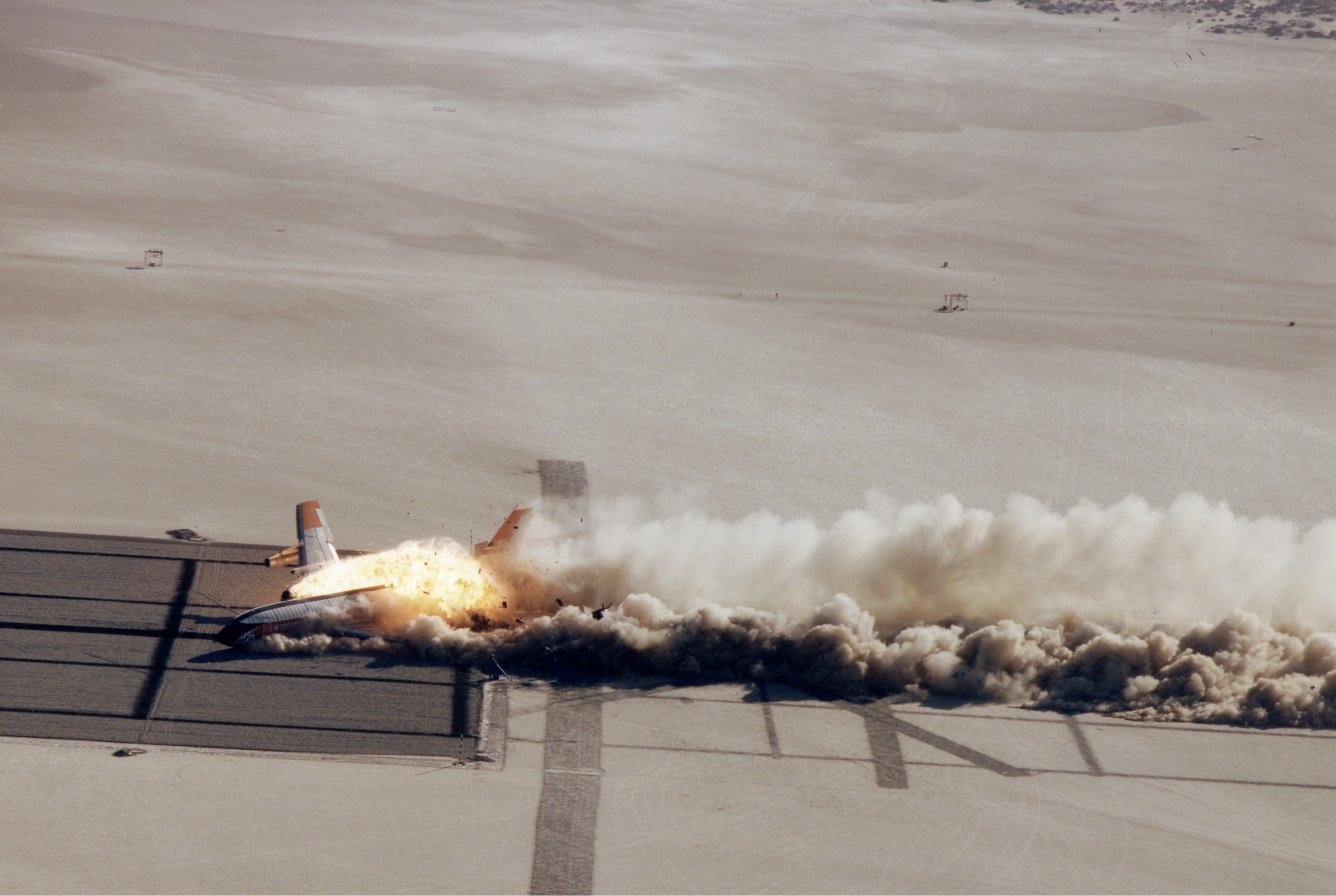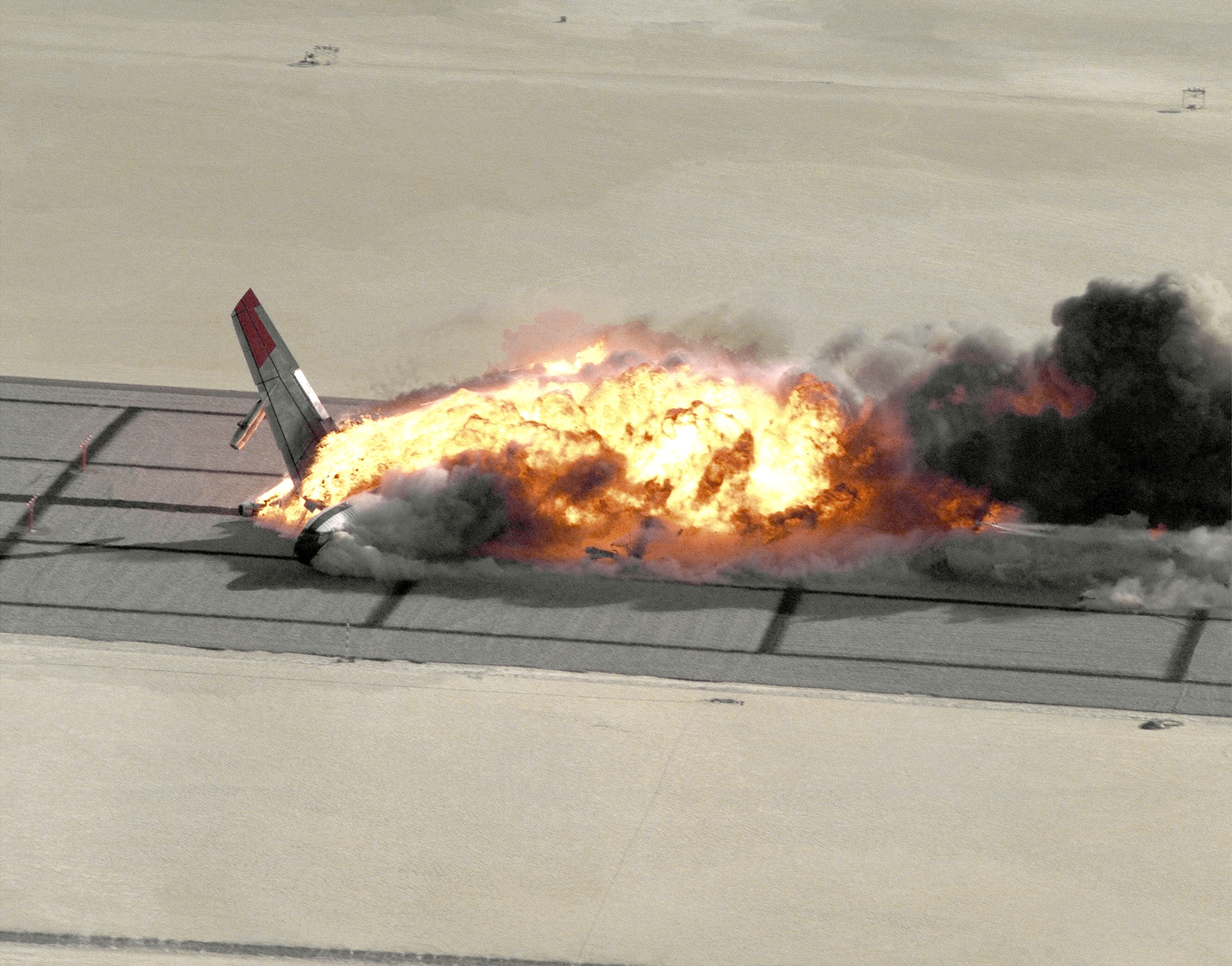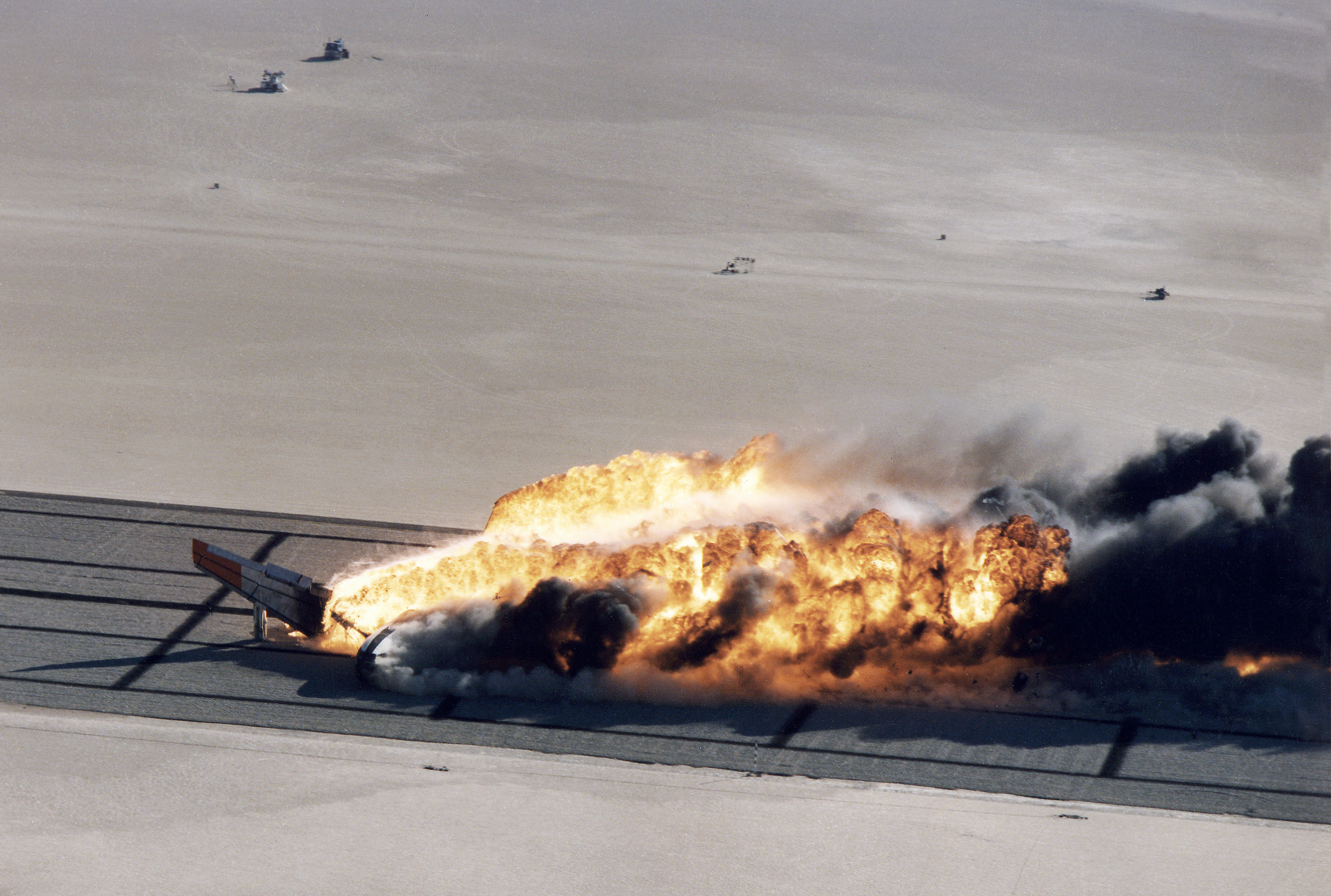Antimisting kerosene on:
[Wikipedia]
[Google]
[Amazon]
The Controlled Impact Demonstration (or colloquially the Crash In the Desert) was a joint project between





 The additive, ICI's FM-9, a high molecular-weight long chain
The additive, ICI's FM-9, a high molecular-weight long chain
File:Boeing 720 Controlled Impact Demonstration.jpg, Closeup of After impact 1
File:Controlled impact demonstration dummies.jpg, Instrumented
NASA
The National Aeronautics and Space Administration (NASA ) is an independent agency of the US federal government responsible for the civil space program, aeronautics research, and space research.
NASA was established in 1958, succeedin ...
and the Federal Aviation Administration
The Federal Aviation Administration (FAA) is the largest transportation agency of the U.S. government and regulates all aspects of civil aviation in the country as well as over surrounding international waters. Its powers include air traffic ...
(FAA) that intentionally crashed a remotely controlled Boeing 720 aircraft to acquire data and test new technologies to aid passenger and crew survival. The crash required more than four years of preparation by NASA Ames Research Center
The Ames Research Center (ARC), also known as NASA Ames, is a major NASA research center at Moffett Federal Airfield in California's Silicon Valley. It was founded in 1939 as the second National Advisory Committee for Aeronautics (NACA) labora ...
, Langley Research Center
The Langley Research Center (LaRC or NASA Langley), located in Hampton, Virginia, United States of America, is the oldest of NASA's field centers. It directly borders Langley Air Force Base and the Back River on the Chesapeake Bay. LaRC has f ...
, Dryden Flight Research Center
The NASA Neil A. Armstrong Flight Research Center (AFRC) is an aeronautical research center operated by NASA. Its primary campus is located inside Edwards Air Force Base in California and is considered NASA's premier site for aeronautical rese ...
, the FAA, and General Electric
General Electric Company (GE) is an American multinational conglomerate founded in 1892, and incorporated in New York state and headquartered in Boston. The company operated in sectors including healthcare, aviation, power, renewable ene ...
. After numerous test runs, the plane was crashed on December 1, 1984. The test went generally according to plan, and produced a spectacular fireball that required more than an hour to extinguish.
The FAA concluded that about one-quarter of the passengers would have survived, that the antimisting kerosene test fuel did not sufficiently reduce the risk of fire, and that several changes to equipment in the passenger compartment of aircraft were needed. NASA concluded that a head-up display
A head-up display, or heads-up display, also known as a HUD (), is any transparent display that presents data without requiring users to look away from their usual viewpoints. The origin of the name stems from a pilot being able to view informa ...
and microwave landing system would have helped the pilot more safely fly the aircraft.
Background and experiment setup

NASA
The National Aeronautics and Space Administration (NASA ) is an independent agency of the US federal government responsible for the civil space program, aeronautics research, and space research.
NASA was established in 1958, succeedin ...
and the Federal Aviation Administration
The Federal Aviation Administration (FAA) is the largest transportation agency of the U.S. government and regulates all aspects of civil aviation in the country as well as over surrounding international waters. Its powers include air traffic ...
(FAA) conducted a joint program for the acquisition, demonstration, and validation of technology for the improvement of transport aircraft occupant crash survivability using a large, four-engine, remotely piloted transport airplane in a controlled impact demonstration (CID). The CID program was conducted at the Dryden Flight Research Facility of NASA Ames Research Center
The Ames Research Center (ARC), also known as NASA Ames, is a major NASA research center at Moffett Federal Airfield in California's Silicon Valley. It was founded in 1939 as the second National Advisory Committee for Aeronautics (NACA) labo ...
(Ames-Dryden), at Edwards, California
Edwards (formerly, Muroc and Wherry Housing) is an unincorporated community in Kern County, California.
It is located east-southeast of Mojave, about northeast of Lancaster, east of Rosamond, and south of California City at an elevation ...
, using a remotely controlled Boeing 720
The Boeing 720 is an American narrow-body airliner produced by Boeing Commercial Airplanes.
Announced in July 1957 as a 707 derivative for shorter flights from shorter runways, the 720 first flew on November 23, 1959.
Its type certificate was ...
transport, and was completed in late 1984. The objectives of the CID program were to demonstrate a reduction of postcrash fire through the use of antimisting fuel, acquire transport crash structural data, and to demonstrate the effectiveness of existing improved seat-restraint and cabin structural systems.Horton and Kempel 1988, p. 1.
The Boeing 720 (tail number N833NA) was purchased new by the FAA in 1960 as a training aircraft.FAA/CT-87/10 1987, p. 5. After more than 20,000 hours and 54,000 takeoff and landing cycles, it had come to the end of its useful life. The aircraft was turned over to NASA-Ames/Dryden Flight Research Center for the CID program in 1981.




 The additive, ICI's FM-9, a high molecular-weight long chain
The additive, ICI's FM-9, a high molecular-weight long chain polymer
A polymer (; Greek '' poly-'', "many" + '' -mer'', "part")
is a substance or material consisting of very large molecules called macromolecules, composed of many repeating subunits. Due to their broad spectrum of properties, both synthetic a ...
, when blended with Jet-A
Jet fuel or aviation turbine fuel (ATF, also abbreviated avtur) is a type of aviation fuel designed for use in aircraft powered by gas-turbine engines. It is colorless to straw-colored in appearance. The most commonly used fuels for commercial av ...
fuel, forms antimisting kerosene (AMK). AMK had demonstrated the capability to inhibit ignition and flame propagation of the released fuel in simulated impact tests. AMK cannot be introduced directly into a gas turbine
A gas turbine, also called a combustion turbine, is a type of continuous flow internal combustion engine. The main parts common to all gas turbine engines form the power-producing part (known as the gas generator or core) and are, in the directio ...
engine due to several possible problems such as clogging of filters. The AMK must be restored to almost Jet-A before being introduced into the engine for burning. This restoration is called degradation and was accomplished on the Boeing 720 using a device called a degrader. Each of the four Pratt & Whitney JT3C
The Pratt & Whitney J57 (company designation: JT3C) is an axial-flow turbojet engine developed by Pratt & Whitney in the early 1950s. The J57 (first run January 1950) was the first 10,000 lbf (45 kN) thrust class engine in the United State ...
-7 engines had a degrader built and installed by General Electric
General Electric Company (GE) is an American multinational conglomerate founded in 1892, and incorporated in New York state and headquartered in Boston. The company operated in sectors including healthcare, aviation, power, renewable ene ...
(GE) to break down and return the AMK to near Jet-A quality.
In addition to the AMK research, NASA Langley Research Center
The Langley Research Center (LaRC or NASA Langley), located in Hampton, Virginia, United States of America, is the oldest of NASA's field centers. It directly borders Langley Air Force Base and the Back River on the Chesapeake Bay. LaRC has f ...
was involved in a structural load measurement experiment, which included using instrumented crash dummies
A crash test dummy, or simply dummy, is a full-scale anthropomorphic test device (ATD) that simulates the dimensions, weight proportions and articulation of the human body during a traffic collision. Dummies are used by researchers, automobil ...
in the seats of the passenger compartment and cockpit. Before the final flight in 1984, more than four years of effort was expended in attempting to establish final impact conditions which would be considered to be survivable by the FAA.
Over a series of 14 flights, General Electric installed and tested four degraders (one on each engine); the FAA refined AMK, blending, testing, and fueling a full size aircraft. During the flights the aircraft made approximately 69 approaches, to about above the prepared crash site, under remote control. These flights were used to introduce AMK one step at a time into some of the fuel tanks and engines while monitoring the performance of the engines. During those same flights, NASA's Dryden Flight Research Center
The NASA Neil A. Armstrong Flight Research Center (AFRC) is an aeronautical research center operated by NASA. Its primary campus is located inside Edwards Air Force Base in California and is considered NASA's premier site for aeronautical rese ...
also developed the remote piloting techniques necessary for the Boeing 720 to fly as a drone aircraft. An initial attempt at the full-scale test was scrubbed in late 1983 due to problems with the uplink connection to the 720; if the uplink failed the ground-based pilot would no longer have control of the aircraft.
Test execution
On the morning of December 1, 1984, the test aircraft took off fromEdwards Air Force Base, California
Edwards Air Force Base (AFB) is a United States Air Force installation in California. Most of the base sits in Kern County, but its eastern end is in San Bernardino County and a southern arm is in Los Angeles County. The hub of the base is Ed ...
, made a left-hand departure and climbed to an altitude of . The aircraft was remotely flown by NASA research pilot Fitzhugh Fulton
Fitzhugh L. "Fitz" Fulton, Jr. (June 6, 1925 – February 4, 2015), (Lt Col, USAF), was a civilian research pilot at NASA's Dryden Flight Research Center, Edwards, California, from August 1, 1966, until July 3, 1986, following 23 years of ...
from the NASA Dryden Remotely Controlled Vehicle Facility. All fuel tanks were filled with a total of of AMK and all engines ran from start-up to impact (flight time was 9 minutes) on the modified Jet-A. It then began a descent-to-landing along the roughly 3.8-degree glideslope to a specially prepared runway on the east side of Rogers Dry Lake
Rogers Dry Lake is an endorheic desert salt pan in the Mojave Desert of Kern County, California. The lake derives its name from the Anglicization from the Spanish name, Rodriguez Dry Lake. It is the central part of Edwards Air Force Base as its ...
, with the landing gear
Landing gear is the undercarriage of an aircraft or spacecraft that is used for takeoff or landing. For aircraft it is generally needed for both. It was also formerly called ''alighting gear'' by some manufacturers, such as the Glenn L. Mart ...
remaining retracted.
Passing the decision height of above ground level (AGL), the aircraft turned slightly to the right of the desired path. The aircraft entered into a situation known as a Dutch roll
Dutch roll is a type of aircraft motion consisting of an out-of- phase combination of "tail-wagging" (yaw) and rocking from side to side (roll). This yaw-roll coupling is one of the basic flight dynamic modes (others include phugoid, short ...
. Slightly above that decision point at which the pilot was to execute a "go-around
In aviation, a go-around is an aborted landing of an aircraft that is on final approach or has already touched down. A go-around can either be initiated by the pilot flying or requested by air traffic control for various reasons, such as an unsta ...
", there appeared to be enough altitude to maneuver back to the center-line of the runway. The aircraft was below the glideslope and below the desired airspeed. Data acquisition systems had been activated, and the aircraft was committed to impact.
The aircraft contacted the ground, left wing low, at full throttle, with the aircraft nose pointing to the left of the center-line. It had been planned that the aircraft would land wings-level, with the throttles set to idle, and exactly on the center-line during the CID, thus allowing the fuselage
The fuselage (; from the French ''fuselé'' "spindle-shaped") is an aircraft's main body section. It holds crew, passengers, or cargo. In single-engine aircraft, it will usually contain an engine as well, although in some amphibious aircraft t ...
to remain intact as the wings were sliced open by eight posts cemented into the runway (called "Rhinos" due to the shape of the "horns" welded onto the posts). The Boeing 720 landed askew. One of the Rhinos sliced through the number 3 engine, behind the burner can, leaving the engine on the wing pylon, which does not typically happen in an impact of this type. The same rhino then sliced through the fuselage, causing a cabin fire when burning fuel was able to enter the fuselage.
The cutting of the number 3 engine and the full-throttle situation was significant, as this was outside the test envelope. The number 3 engine continued to operate for approximately 1/3 of a rotation,FAA/CT-87/10 1987, p. 17. degrading the fuel and igniting it after impact, providing a significant heat source. The fire and smoke took over an hour to extinguish. The CID impact was spectacular with a large fireball created by the number 3 engine on the right side, enveloping and burning the aircraft. From the standpoint of AMK the test was a major set-back. For NASA Langley, the data collected on crashworthiness
Crashworthiness is the ability of a structure to protect its occupants during an impact. This is commonly tested when investigating the safety of aircraft and vehicles. Depending on the nature of the impact and the vehicle involved, different crit ...
was deemed successful and just as important.
Findings
The actual impact demonstrated that the antimisting additive tested was not sufficient to prevent a post-crash fire in all circumstances, though the reduced intensity of the initial fire was attributed to the effect of AMK.FAA/CT-87/10 1987, pp. 20–22. FAA investigators estimated that 23–25% of the aircraft's full complement of 113 people could have survived the crash. Time from slide-out to complete smoke obscuration for the forward cabin was 5 seconds; for the aft cabin, it was 20 seconds. Total time to evacuate was 15 and 33 seconds respectively, accounting for the time necessary to reach and open the doors and operate the slide. Investigators labeled their estimate of the ability to escape through dense smoke as "highly speculative".FAA/CT-87/10 1987, pp. 39–40. As a result of analysis of the crash, the FAA instituted new flammability standards for seat cushions which required the use of fire-blocking layers, resulting in seats which performed better than those in the test.FAA/CT-87/10 1987, p. 33. It also implemented a standard requiring floor proximity lighting to be mechanically fastened, due to the apparent detachment of two types of adhesive-fastened emergency lights during the impact.FAA/CT-87/10 1987, p. 38. Federal aviation regulations forflight data recorder
A flight recorder is an electronic recording device placed in an aircraft for the purpose of facilitating the investigation of aviation accidents and incidents. The device may often be referred to as a "black box", an outdated name which has ...
sampling rates for pitch, roll and acceleration were found to be insufficient.FAA/CT-87/10 1987, p. 39.
NASA concluded that the impact piloting task was of an unusually high workload, which might have been reduced through the use of a heads-up display
A head-up display, or heads-up display, also known as a HUD (), is any transparent display that presents data without requiring users to look away from their usual viewpoints. The origin of the name stems from a pilot being able to view informa ...
, the automation of more tasks, and a higher-resolution monitor. It also recommended the use of a microwave landing system to improve tracking accuracy over the standard instrument landing system
In aviation, the instrument landing system (ILS) is a precision radio navigation system that provides short-range guidance to aircraft to allow them to approach a runway at night or in bad weather. In its original form, it allows an aircraft to ...
. In practice, the Global Positioning System
The Global Positioning System (GPS), originally Navstar GPS, is a satellite-based radionavigation system owned by the United States government and operated by the United States Space Force. It is one of the global navigation satellite ...
-based Wide Area Augmentation System
The Wide Area Augmentation System (WAAS) is an air navigation aid developed by the Federal Aviation Administration to augment the Global Positioning System (GPS), with the goal of improving its accuracy, integrity, and availability. Essentia ...
came to fulfill this role.Horton and Kempel 1988, pp. 15–19.
crash dummies
A crash test dummy, or simply dummy, is a full-scale anthropomorphic test device (ATD) that simulates the dimensions, weight proportions and articulation of the human body during a traffic collision. Dummies are used by researchers, automobil ...
File:Controlled Impact Demonstration.ogg, Controlled Impact Demonstration (CID) sequence
File:Controlled Impact Demonstration 2.ogg, CID Aircraft in practice flight above target impact site with wing cutters
File:Controlled Impact Demonstration 3.ogg, Controlled Impact Demonstration (CID) tail camera video
See also
* 2012 Boeing 727 crash experimentReferences
Citations
Sources
* *External links
* * * * * {{cite magazine , url=https://www.flightglobal.com/pdfarchive/view/1984/1984%20-%200611.html , title=Fuel for the fire? , date=1984-04-07 , magazine=Flight International , number=3909 , volume=125 , issn=0015-3710 Aviation safety NASA programs Ames Research Center Experiments Langley Research Center Federal Aviation Administration 1984 in California December 1984 events in the United States Articles containing video clips Unmanned aerial vehicles of the United States